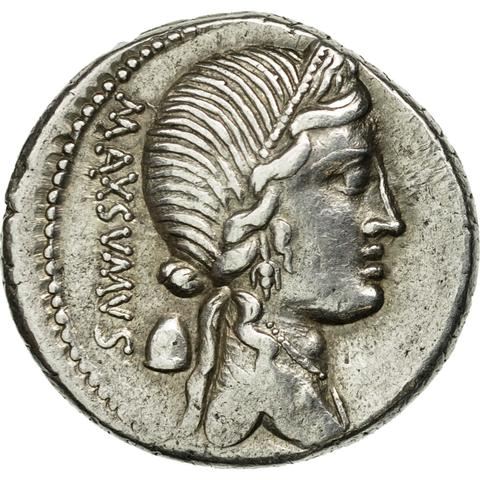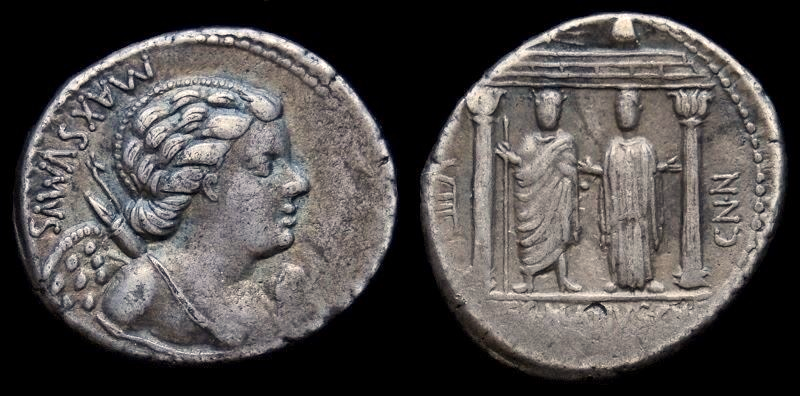C. Egnatius Maximus was one of the moneyers for the year 75 BC. He is possibly the younger brother of the Cn. Egnatius mentioned by Cicero.
Gens Egnatia was a plebeian family of equestrian rank at Rome. Only a few of the Egnatii held any magistracies, of whom the most important may have been Gnaeus Egnatius, who held the praetorship during the second century BC, and served as governor of Macedonia, shortly after its institution as a Roman province.
The Egnatii do not seem to have been divided into distinct families during the time of the Republic. Most of the Egnatii bore no cognomen, but individuals are known with the surnames Celer, Maximus, Rufus, and Veratius. Celer means "swift," while Maximus is "great" or "greatest." Rufus, meaning "red," was typically given to someone with red hair or a ruddy complexion.
Gens Egnatia was a plebeian family of equestrian rank at Rome. Only a few of the Egnatii held any magistracies, of whom the most important may have been Gnaeus Egnatius, who held the praetorship during the second century BC, and served as governor of Macedonia, shortly after its institution as a Roman province.
The Egnatii do not seem to have been divided into distinct families during the time of the Republic. Most of the Egnatii bore no cognomen, but individuals are known with the surnames Celer, Maximus, Rufus, and Veratius. Celer means "swift," while Maximus is "great" or "greatest." Rufus, meaning "red," was typically given to someone with red hair or a ruddy complexion.


Obverse: Winged bust of Cupid right; bow and quiver of arrows over shoulder; MAXSVMVS downwards in left field.
Reverse: Distyle temple with two facing statues within; Jupiter, to the left, holding staff, and Libertas, on the right, holding pileus. Above pediment, thunderbolt and pileus. VIII (control mark) in left field; CN•N in right field; C•EGNATIVS•CN•F in exergue.
Diameter:
19 mm
Die Orientation: -
Weight: 3.98 g
Die Orientation: -
Weight: 3.98 g
"The Egnatii were of Samnite origin, and at least some of them had settled at Teanum. At the end of the Social War, the greater part of these appear to have relocated to Rome, where two of them were admitted into the senate, though a branch of the family seems to have remained at Teanum.
This moneyer, a man of somewhat disreputable character, was admitted into the Roman senate, but was subsequently expelled by the censors. Not much more is known about him.
In Catullus love poetry, Cupid and Venus are constantly paired as the patrons of all sensual love and they have maintained the same symbolism even today for people who no longer worship the gods. The bust of Cupid so prominently placed on the obverse of Egnatius coin, depicted with his cherub-like features and armed with a bow whose arrows only wound one's heart with passion and desire, but never kill, is symbolic of peace and the pleasure it brings.
This issue is the only surviving record of the Temple of Jupiter Libertas. The temple of Libertas was built on the Aventine hill ca 246 B.C by the plebeian aediles Tiberius Sempronius Gracchus and Gaius Fundanius. The money to finance the erection of the temple came from fines. The main contributor was Claudia, the sister of the consul of 249 B.C, Publius Claudius Pulcher. On an occasion when she found it hard to make her way through the crowded streets of Rome she exclaimed that she wished her brother was still alive to lose another fleet for the Romans for that would thin out the population a little. That insensitive comment cost her 25.000 asses.
In the course of time the temple came to be better known as the temple of Jupiter Libertas. The original connection between the two deities may be found in the belief that Libertas was the daughter of Jupiter and Juno. Egnatius depiction of the temple shows its true bipartite nature at that time. It was restored by Augustus as part of his grand renovation of Rome.”
Provenance: Purchased from Moruzzi Numismatica (5 March 2018). Ex Varesi 63 (26 November 2013), lot 46.
This moneyer, a man of somewhat disreputable character, was admitted into the Roman senate, but was subsequently expelled by the censors. Not much more is known about him.
In Catullus love poetry, Cupid and Venus are constantly paired as the patrons of all sensual love and they have maintained the same symbolism even today for people who no longer worship the gods. The bust of Cupid so prominently placed on the obverse of Egnatius coin, depicted with his cherub-like features and armed with a bow whose arrows only wound one's heart with passion and desire, but never kill, is symbolic of peace and the pleasure it brings.
This issue is the only surviving record of the Temple of Jupiter Libertas. The temple of Libertas was built on the Aventine hill ca 246 B.C by the plebeian aediles Tiberius Sempronius Gracchus and Gaius Fundanius. The money to finance the erection of the temple came from fines. The main contributor was Claudia, the sister of the consul of 249 B.C, Publius Claudius Pulcher. On an occasion when she found it hard to make her way through the crowded streets of Rome she exclaimed that she wished her brother was still alive to lose another fleet for the Romans for that would thin out the population a little. That insensitive comment cost her 25.000 asses.
In the course of time the temple came to be better known as the temple of Jupiter Libertas. The original connection between the two deities may be found in the belief that Libertas was the daughter of Jupiter and Juno. Egnatius depiction of the temple shows its true bipartite nature at that time. It was restored by Augustus as part of his grand renovation of Rome.”
Provenance: Purchased from Moruzzi Numismatica (5 March 2018). Ex Varesi 63 (26 November 2013), lot 46.
Crawford 391/2
.jpg)
Obverse: Winged bust of Cupid right, with bow and quiver over shoulder; behind, MAXSVMVS downwards
Reverse: Distyle temple with figures of draped Jupiter and Libertas standing facing within; C EGNATIVS CN F below, CN N upwards to right, control numeral (VIII) to left
Diameter:
19 mm
Die Orientation: 2 H
Weight: 3.96 g
Die Orientation: 2 H
Weight: 3.96 g
No notes for this coin
RSC Egnatia 3; Crawford 391/2; Sear 325
